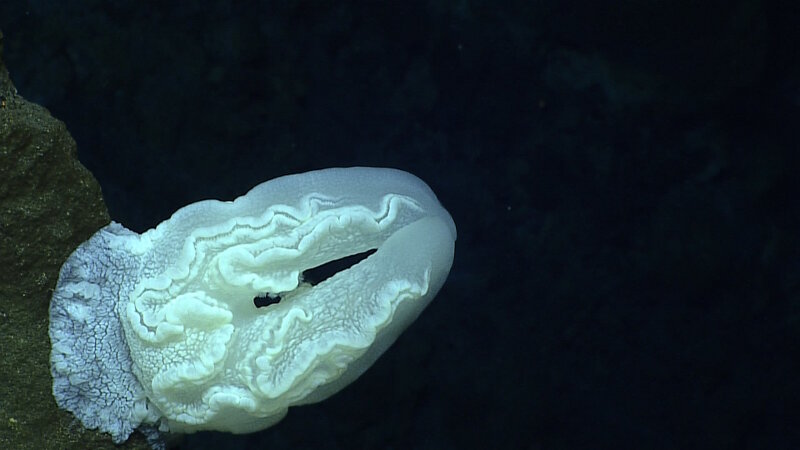
One of the unusual benthic platyctenid ctenophores documented during Dive 5 at Ahyi Seamount. Image courtesy of the NOAA Office of Ocean Exploration and Research, 2016 Deepwater Exploration of the Marianas. Download larger version (jpg, 480 KB).

One of the unusual benthic platyctenid ctenophores documented during Dive 5 at Ahyi Seamount. Image courtesy of the NOAA Office of Ocean Exploration and Research, 2016 Deepwater Exploration of the Marianas. Download larger version (jpg, 480 KB).
What is That?
While exploring Ahyi Seamount during Dive 5 of the leg, we encountered a range of sessile organisms that made scientists exclaim, 'what is that?!' These included a benthic ctenophore, a rare anemone (possibly in the genus Alicia), and a sea slug (or nudibranch). A frequent topic among the science team during the dive was if these organisms had recently taken up residence in the area or if they had resided in this area prior to a documented eruption of the seamount in 2014. Video courtesy of the NOAA Office of Ocean Exploration and Research, 2016 Deepwater Exploration of the Marianas. Download (mp4, 146.7 MB)
Today's dive at Ahyi Seamount, part of a string of active submarine volcanoes along the Mariana arc, was another one that offered a diversity of geology and biology. After a cloudy descent, remotely operated vehicle Deep Discoverer (D2) explored the upper portion of Ahyi, which erupted most recently in April and May of 2014. The goals of this dive were to explore and characterize any evidence of change since the last eruption, sample any new lava, and assess the impacts of the eruption on the local marine ecosystem. Our exploration started at 358 meters depth and we saw mostly fragmental material thrown out by the volcano; white sulfur mats and yellow iron mats; animals associated with hydrothermal vent environments, suggesting a vent may be nearby; and massive cliffs that form the seamounts. Because this was a volcanically active environment, there was very little sessile life. We observed two octopuses moving across the seafloor, a deepwater sand tiger shark, a snake mackerel (a new record of occurrence in the Marianas), a cusk eel, a duckbill, a flatfish, and a colony of shrimp. Sessile organisms we encountered included benthic ctenophores, a rare anemone (possibly in the genus Alicia), and a sea slug. A frequent topic among the science team during the dive was if these organisms had recently taken up residence here or if they had resided in this area prior to the 2014 eruption.